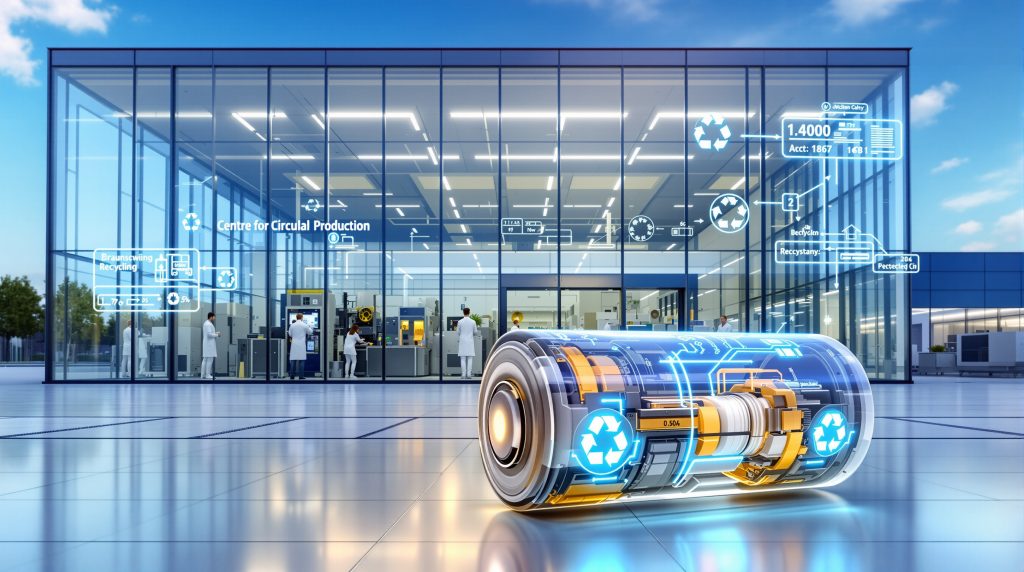Pioneering Circular Battery Economy: Inside Braunschweig University's New Research Centre
The future of sustainable energy storage is taking shape in Lower Saxony, Germany, where the Technical University of Braunschweig is establishing a groundbreaking research facility dedicated to creating a circular economy for batteries and fuel cells. This innovative center represents a paradigm shift in how we approach battery production, usage, and end-of-life management—focusing on sustainability from the very beginning of the design process.
What is the Centre for Circular Production of Next Batteries and Fuel Cells (CPC)?
The Centre for Circular Production of Next Batteries and Fuel Cells (CPC) represents a revolutionary initiative that will transform how batteries are designed, manufactured, and recycled. This €73 million facility, currently under construction at Braunschweig Research Airport, will serve as a hub for approximately 150 scientists dedicated to developing circular economy solutions for energy storage technologies.
Unlike traditional research facilities that focus solely on performance improvements, the CPC takes a holistic approach by integrating recyclability into the earliest stages of battery development. The core philosophy is "design for recycling"—creating batteries and fuel cells that are inherently recyclable from their inception rather than attempting to develop recycling solutions after products are already in the market.
The 3,700 square meter state-of-the-art facility is scheduled to begin operations in 2027, establishing a new benchmark for sustainable energy storage research in Europe and beyond.
Key Features of the CPC Research Centre
- Cutting-edge Infrastructure: 3,700 square meters of specialized laboratory and research space
- Substantial Investment: €73 million total funding from government and university sources
- Research Capacity: Home to approximately 150 scientific researchers
- Strategic Location: Positioned at Braunschweig Research Airport within a broader innovation ecosystem
- Timeline: Scheduled completion and operation by 2027
- Core Focus: Developing batteries and fuel cells designed for complete material recovery and reuse
How is the CPC Research Centre Being Funded?
The establishment of this innovative research facility represents a significant financial commitment from multiple stakeholders, demonstrating Germany's dedication to sustainable energy technology development. The funding structure highlights the collaborative approach between regional and national government entities alongside academic institutions.
Funding Breakdown
| Funding Source | Amount (€ millions) | Percentage |
|---|---|---|
| State of Lower Saxony | 38.6 | 52.9% |
| German Federal Government | 26.4 | 36.2% |
| Technical University of Braunschweig | 8.0 | 10.9% |
| Total | 73.0 | 100% |
This funding distribution showcases the State of Lower Saxony's commitment to establishing regional excellence in sustainable technology, with the federal government providing substantial support to ensure the project's success. The Technical University of Braunschweig's financial contribution demonstrates its institutional commitment to advancing circular economy solutions.
Why is the Circular Battery Economy Essential for Sustainability?
The rapid global transition to renewable energy and electric transportation has created an unprecedented demand for batteries. While this shift away from fossil fuels offers significant environmental benefits, it also creates new sustainability challenges—particularly regarding the raw materials required for battery production and the waste generated at end-of-life.
The Critical Raw Materials Challenge
Current battery production relies heavily on a linear "take-make-dispose" model that creates significant sustainability challenges:
- Resource Depletion: Finite supplies of lithium, cobalt, nickel, and other critical minerals face growing pressure as demand accelerates
- Environmental Impact: Mining operations for battery materials often create significant ecological damage, including water pollution, habitat destruction, and carbon emissions
- Geopolitical Vulnerabilities: Supply chain concentration in specific regions creates economic and security risks for battery-dependent industries
- Waste Management: Improper disposal of batteries leads to hazardous material contamination and loss of valuable resources
- Economic Inefficiency: Discarding batteries after use wastes materials that could be recovered and recirculated at a fraction of the environmental and economic cost of new extraction
The Circular Economy Solution
The CPC's approach fundamentally reimagines battery development through a circular economy lens. Rather than treating recycling as an afterthought, the center will integrate recyclability into the earliest stages of design and development:
- Material Selection: Prioritizing materials that maintain performance while enabling efficient recovery
- Structural Design: Creating battery architectures that facilitate disassembly and component separation
- Production Processes: Developing manufacturing techniques that minimize material losses and energy consumption
- Recovery Systems: Engineering specialized processes for efficiently extracting and purifying valuable materials
- Closed-Loop Verification: Testing recovered materials to ensure they maintain necessary performance characteristics in new batteries
This holistic approach aims to create a self-sustaining cycle where batteries at end-of-life become the raw material source for the next generation of energy storage technologies. Recent battery recycling breakthrough research has already shown promising results in this area.
How Will the CPC Transform Battery Production and Recycling?
Innovative Research Approaches
The CPC will function as what Professor Arno Kwade describes as a "circular research factory," developing groundbreaking methodologies to revolutionize battery sustainability. This unique approach integrates both experimental and digital research techniques to solve complex recycling challenges.
Key research focus areas include:
- Function-Preserving Material Cycles: Developing processes that maintain the critical performance characteristics of materials through multiple life cycles
- Energy-Efficient Recycling: Creating recycling techniques that minimize energy consumption while maximizing material recovery
- Integrated Production-Recycling Systems: Designing manufacturing processes that inherently support eventual recycling
- Digital Simulation Models: Using computational tools to optimize battery designs for both performance and recyclability
- Cross-Disciplinary Innovation: Combining expertise from materials science, engineering, chemistry, and sustainability fields
This multifaceted research approach aims to overcome the current limitations of battery recycling, where processes are often energy-intensive and yield materials of inconsistent quality. The center will build on existing closed-loop battery recycling initiatives to develop more efficient and effective methods.
Strategic Integration with Regional Expertise
The CPC will not operate in isolation but rather as part of an interconnected ecosystem of research excellence in Lower Saxony:
- Battery LabFactory Braunschweig (BLB): Established battery research facility providing complementary expertise
- Fraunhofer Centre for Energy Storage and Systems (ZESS): Applied research partner focused on system-level integration
- Braunschweig LabFactories for Batteries and more (BLB+): Network connecting various specialized laboratories
- Academic Partnerships: Collaboration with Clausthal University of Technology, PTB (National Metrology Institute), and Leibniz University Hannover
This networked approach creates a powerful innovation ecosystem capable of addressing the full spectrum of challenges in developing truly circular battery technologies.
What Makes the CPC's Location Strategically Important?
The Braunschweig Research Ecosystem
The CPC's strategic location at Braunschweig Research Airport places it within one of Germany's most dynamic innovation clusters focused on sustainable mobility and energy technologies:
- Physical Proximity: Immediate adjacency to the Lower Saxony Research Centre for Vehicle Technology (NFF) and the Lower Saxony Research Centre for Aviation (NFL)
- Research Synergies: Close collaboration with the Fraunhofer Centre for Energy Storage and Systems (ZESS)
- Industry Connections: Access to regional automotive and energy sector partners
- Academic Integration: Strong ties to multiple universities and research institutes
This geographic positioning facilitates rapid knowledge transfer between complementary research domains. For example, advances in vehicle electrification at the NFF can inform battery design requirements at the CPC, while circular economy innovations from the CPC can be quickly integrated into vehicle development processes.
Infrastructure Advantages
The Braunschweig Research Airport location provides practical benefits that enhance the center's research capabilities:
- Specialized Facilities: Access to shared testing and characterization equipment
- Transportation Links: Excellent connectivity for visiting researchers and industry partners
- Expansion Potential: Room for future growth as research programs develop
- Safety Considerations: Appropriate environment for conducting potentially hazardous material experiments
These logistical advantages ensure that the CPC can focus its resources on groundbreaking research rather than duplicating existing infrastructure.
How Will the CPC Contribute to Germany's Technological Leadership?
Advancing Germany's High-Tech Agenda
According to Professor Arno Kwade, designated spokesperson for the CPC and head of the Battery LabFactory Braunschweig, the center will make "a decisive contribution to Germany's high-tech agenda and technological sovereignty." This contribution takes several concrete forms:
- Strategic Independence: Reducing reliance on imported battery technology and materials
- Intellectual Property Development: Creating patentable innovations in sustainable battery design
- Skills Development: Training specialized researchers in advanced circular economy approaches
- Industry Transformation: Providing technological foundations for modernizing Germany's industrial base
- Climate Leadership: Supporting Germany's ambitious decarbonization targets
The CPC represents an investment not just in a research facility but in Germany's ability to lead in one of the most critical technology sectors of the coming decades. This effort aligns with broader energy transition insights that emphasize the importance of sustainable materials management.
Building a World-Class Research Hub
The CPC forms part of a broader strategic vision to establish the BLB+ consortium as one of Germany's three premier battery research centers. This ambitious goal reflects the recognition that battery technology will remain foundational to multiple industries, from automotive to renewable energy integration.
The center's long-term impact will extend beyond specific technological innovations to include:
- Standardization Leadership: Developing protocols that can become global standards for battery recycling
- Policy Guidance: Providing evidence-based recommendations for regulatory frameworks
- Educational Excellence: Attracting top research talent and students to the region
- Industrial Transformation: Supporting the transition of regional businesses to circular economy models
- International Collaboration: Establishing partnerships with complementary research centers worldwide
This comprehensive approach positions the CPC to influence the global trajectory of battery technology toward more sustainable models.
What Technologies Will the CPC Focus On?
Next-Generation Battery and Fuel Cell Systems
The CPC will investigate a diverse range of energy storage technologies, with particular emphasis on designs that facilitate material recovery:
- Advanced Lithium-Ion Architectures: Developing battery structures that maintain performance while enabling easier disassembly
- Solid-State Battery Systems: Exploring solid electrolytes that offer both performance and recyclability advantages
- Hydrogen Fuel Cell Technologies: Creating fuel cell designs that facilitate precious metal catalyst recovery
- Flow Battery Concepts: Investigating systems with inherently recyclable liquid electrolytes
- Hybrid Storage Solutions: Combining multiple technologies to optimize both performance and end-of-life management
Each technology stream will be evaluated not just for its performance characteristics but for its complete lifecycle impact, including material sourcing, manufacturing efficiency, and recyclability. Advances in lithium extraction technology will also inform the center's research directions.
Innovative Recycling Methodologies
The center will develop cutting-edge approaches to material recovery that go beyond current industrial practices:
- Direct Recycling Techniques: Methods that preserve the complex structures of battery materials rather than breaking them down completely
- Selective Extraction Processes: Technologies that target specific high-value materials with minimal energy input
- Biological Recovery Systems: Exploring enzyme and microbe-based approaches to material separation
- Automated Disassembly: Developing robotics and sensing systems for efficient battery dismantling
- Quality Verification Methods: Creating standardized techniques for assessing recovered material quality
These research streams aim to overcome the efficiency and quality limitations of current recycling methods, which often recover only a portion of battery materials and require significant energy inputs.
How Will the CPC Impact the Future of Battery Sustainability?
Transforming Battery Lifecycles
The CPC's research has the potential to fundamentally transform how batteries move through their lifecycle:
- Extended Primary Use: Designs that maintain performance longer before requiring recycling
- Streamlined Second-Life Applications: Simplified pathways for repurposing batteries in less demanding applications
- Standardized Disassembly: Common design elements that facilitate automated recycling
- Material Passport Systems: Digital tracking of battery components throughout their lifecycle
- Circular Supply Chains: Creating closed loops where recycled materials consistently return to production
These innovations could transform batteries from disposable products into renewable material resources, dramatically reducing the environmental footprint of energy storage technologies. The insights gained will likely inform the design of future battery recycling facility developments worldwide.
Economic and Environmental Benefits
The circular battery economy promoted by the CPC offers significant advantages across multiple dimensions:
- Cost Reduction: Decreasing battery production costs through material recirculation
- Resource Security: Stabilizing supply chains through reduced dependence on primary mining
- Carbon Footprint Reduction: Lowering greenhouse gas emissions associated with battery production
- Waste Minimization: Preventing hazardous materials from entering landfills
- Job Creation: Developing new industries in battery refurbishment and recycling
"Circular battery design represents not just an environmental necessity but an economic opportunity. By recovering and reusing valuable materials, we can simultaneously reduce costs, secure supply chains, and minimize environmental impact." — Battery sustainability experts generally agree with this perspective.
FAQ: Circular Battery Economy Research
What is a circular battery economy?
A circular battery economy refers to a system where batteries are designed, manufactured, used, and recycled in ways that maximize resource efficiency and minimize waste. Unlike the traditional linear approach (extract, manufacture, use, dispose), circular systems keep materials in use through multiple product lifecycles. For batteries, this means designing components that can be easily separated, recovered, and reintegrated into new products with minimal quality loss.
Why is battery recycling challenging?
Current battery recycling faces multiple technical challenges:
- Complex Structures: Batteries contain multiple materials bonded together in ways that make separation difficult
- Material Degradation: Some recycling processes damage materials, reducing their value for reuse
- Process Energy: Many current recycling methods require significant energy input
- Design Variation: Lack of standardization complicates automated disassembly
- Economic Barriers: The cost of recycling sometimes exceeds the value of recovered materials
The CPC aims to address these challenges through integrated design-for-recycling approaches rather than trying to solve recycling problems after batteries are already manufactured.
How does the circular approach differ from traditional battery production?
Traditional battery production focuses almost exclusively on performance metrics like energy density, power capability, and cost, with recyclability considered a secondary concern if at all. The circular approach balances performance requirements with end-of-life considerations from the earliest design stages.
Key differences include:
- Material Selection: Choosing materials that maintain performance while enabling recovery
- Structural Design: Creating architectures that facilitate disassembly
- Manufacturing Processes: Developing production techniques that minimize material losses
- Supply Chain Integration: Establishing connections between production and recycling systems
- Performance Metrics: Including recyclability as a core performance indicator
This holistic approach requires collaboration across disciplines and throughout the value chain, which the CPC's structure is specifically designed to facilitate.
What role will digital technologies play in circular battery production?
Digital technologies will be critical enablers of the circular battery economy:
- Digital Twins: Virtual models that simulate battery performance and degradation
- Lifecycle Tracking: Systems for monitoring materials from production through recycling
- Process Optimization: AI-powered tools for maximizing recycling efficiency
- Quality Verification: Automated systems for assessing recovered material properties
- Design Simulation: Computational models for evaluating recyclability during design
The CPC's approach of developing both experimental and digital methodologies reflects the essential role that digital tools will play in realizing the circular battery economy vision.
Further Exploration:
Readers interested in learning more about circular battery economy initiatives can explore related educational content available from Braunschweig University of Technology's official resources at tu-braunschweig.de.
Want to Profit from the Next Major Mineral Discovery?
Stay ahead of the market with Discovery Alert's proprietary Discovery IQ model, which instantly notifies you of significant ASX mineral discoveries and translates complex data into actionable investment insights. Visit our discoveries page to understand how historic discoveries have generated substantial returns and begin your 30-day free trial today.




